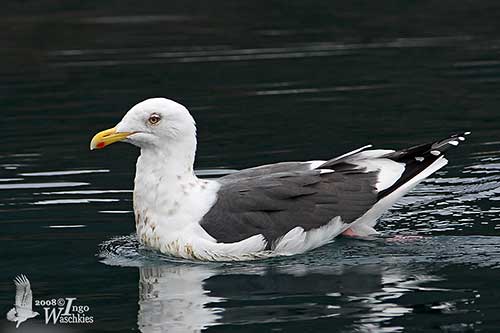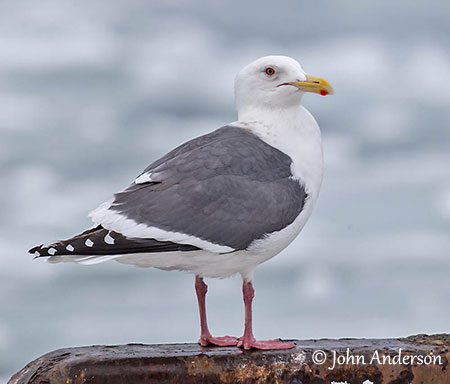
Fr: Goéland à manteau ardoisé
Ang: Slaty-backed Gull
All: Kamtschatkamöwe
Esp: Gaviota de Kamchatka
Ita: Gabbiano dorsoardesia
Nd: Kamtsjatkameeuw
Sd: skiffertrut
Photographers:
John Anderson
John Anderson Photo Galleries
Otto Plantema
Trips around the world
William Price
PBase-tereksandpiper & Flickr William Price
Ingo Waschkies
My bird pictures on Pbase
Text by Nicole Bouglouan
Sources:
HANDBOOK OF THE BIRDS OF THE WORLD Vol 3 by Josep del Hoyo-Andrew Elliott-Jordi Sargatal - Lynx Edicions - ISBN: 8487334202
What Bird-The ultimate Bird Guide (Mitchell Waite)
Wikipedia, the free encyclopaedia
Alaska Seabird Information Series
Slaty-backed Gull
Larus schistisagus
Charadriiformes Order – Laridae Family
INTRODUCTION:
The Slaty-backed Gull is one of the largest gulls in the family Laridae. It has stocky body, powerful head and fairly short bill. Relatively similar to other large gulls, it is usually identified in flight by its distinct wing pattern.
It breeds along seacoasts and on rocky islets, often inaccessible locations. It typically feeds on fish and marine prey, but some other types of food items are also taken, depending on both location and season.
The Slaty-backed Gull is not globally threatened, although both direct and indirect human impacts may affect the populations, especially fishing nets and long-lines fisheries.
DESCRIPTION OF THE BIRD:
Biometrics:
Length: 55-67 cm
Wingspan: 132-148 cm
Weight: 1050-1700 g
The Slaty-backed Gull in breeding plumage has deep slate-grey mantle and upperwings. We can see a broad white trailing edge, mostly black on outer primary feathers, and a distinct black-and-white wingtip pattern.
On the underwings, there is a “string of pearls” pattern similar to the upperwings, formed by a row of black primaries with white tips, and a line of translucent spots crossing the grey colour.
This pattern is the main identification feature of this species. Actually, the underwing pattern appears tricoloured.
Head, under body and tail are white.
The short, stout bill is yellow with red gonydal spot. The eyes are pale yellow, surrounded by narrow pinkish orbital ring. Legs and feet are pink.
Male and female have similar plumage, but the male is slightly larger than the female.

The non-breeding adult shows brownish streaks on head, neck and breast sides. The bill is duller, paler yellow with pinkish base and dark subterminal tip.
The juvenile is greyish-brown with pale edges on mantle and scapulars. On the upperwings, tertials and wing-coverts are pale with slightly barred inner greater coverts. The flight feathers are mostly brown with a pale area on inner primaries. The tail is dark and contrasts with the paler, spotted uppertail-coverts. The bill is black. Legs and feet are pink.
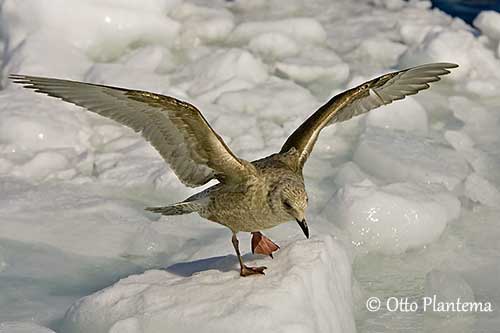
The first winter is paler with some dark streaks on the back. The pinkish base of the bill may appear.
The second winter develops a slaty-grey back, but it is pale-patterned with whitish wing-coverts.
The third winter resembles adult but it has scattered brown on wing-coverts, and the tail may show broad, dark markings.
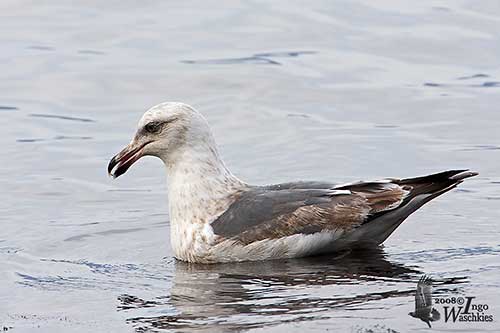
RANGE:
The Slaty-backed Gull breeds in the Russian Far East along the mainland coast, from the Koryak Highlands in N to the southern boundary between Russia and China.
Colonies are present on Kamchatka Peninsula and through Kuril Islands, Sea of Okhotsk to Hokkaido and N Honshu, Japan. It also breeds in NW Alaska, in Aniktun.
This species winters from Bering Sea to Sea of Japan, but rarely S to coasts of China and Taiwan.
HABITAT:
The Slaty-backed Gull usually breeds on seacliffs and rocky islands, often inaccessible locations. However, it may also nest on sandy shores. In Kamchatka, the colonies are established on freshwater lake’s islands, up to 20 kilometres away from the sea.
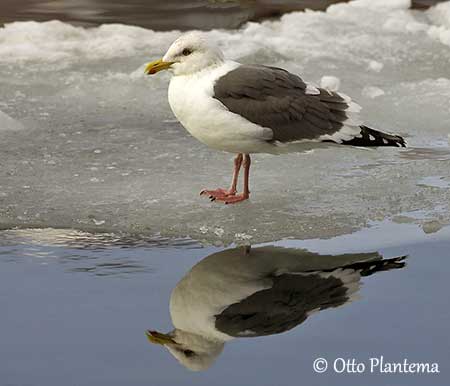
CALLS AND SONGS: SOUNDS BY XENO-CANTO
The Slaty-backed Gull gives deep, guttural “kaaw” or “klaaw”. The long call is slower and deeper than in Western Gull.
BEHAVIOUR IN THE WILD:
The Slaty-backed Gull feeds primarily on fish and marine invertebrates including crabs and sea urchins, but it also takes carrion, offal, bird’s eggs and chicks, rodents and insects, depending on the range.
During the period of salmon-spawning, it feeds on fish and fish eggs, and often benefits from remains of bear-kills.
According to the season, it eats crowberries in late summer, whereas during winter, it scavenges around fisheries and slaughterhouses.
Adults, chicks and eggs of various seabird species are taken too, both Laridae and Alcidae.
At sea, it forages typically by plunge-diving and surface-plunging to catch prey.
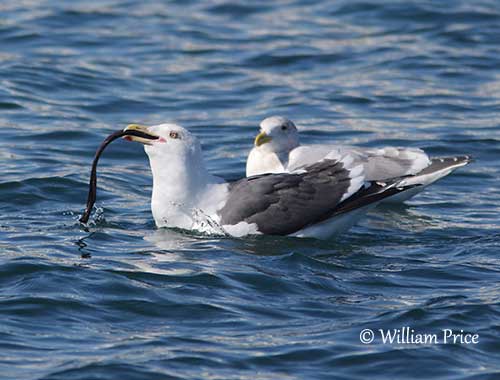
The Slaty-backed Gull breeds in colonies where the density is about 2 nests/m² but when they are established on slopes, the nests are more scattered. The birds are territorial and defend a small area around the nest. They become very vocal and the displays are accompanied by calls.
The typical “long call” is given by a bird raising the head above the horizontal, before to gradually lower it while uttering a series of long notes, often followed by a series of “head-tosses” with the heads thrown over back while giving a plaintive note.
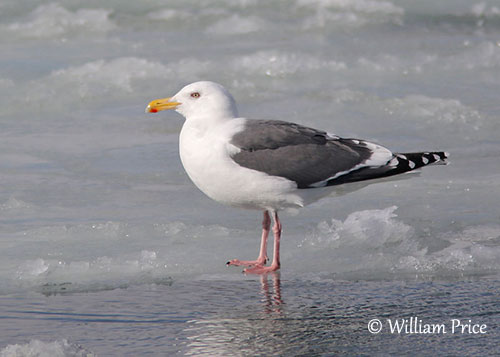
Many populations only disperse into Bering Sea and Sea of Japan, but some other populations migrate S towards coasts of China.
Vagrants are recorded widely in North America, and there are recent records from the West Palearctic too.
The Slaty-backed Gull is a powerful, agile flier, performing several rapid wingbeats interspersed with glides.
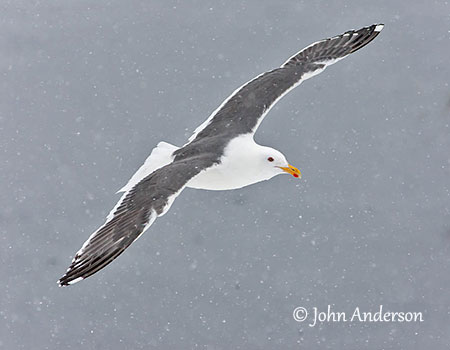
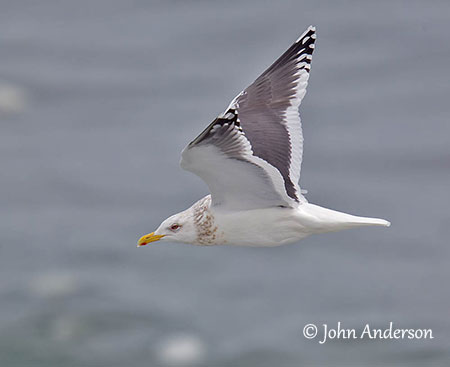
REPRODUCTION OF THIS SPECIES:
The laying occurs from late May in S to early June in N of the range. The colonies may include from a few pairs to over a thousand pairs. They are often established near or among other seabird species on sloping cliff tops, cliff edges, rocky islands and sandy shores.
The nest is on the ground, usually close to the cliff face, protected by dense vegetation or boulders. It is made with grass, seaweeds and feathers.
The female lays 1-4, usually 3 cryptic eggs. Both adults share the incubation during about one month, from 28-30 days to 31-33 days, depending on the range. The chicks are grey-brown with black spots above, on breast and head. Both parents feed them during 40-45 days. The first flight occurs at 49-56 days of age.
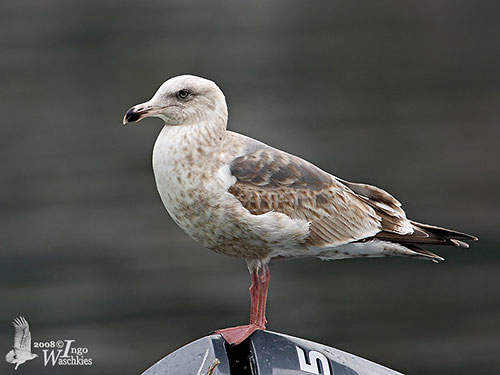
PROTECTION / THREATS / STATUS:
The Slaty-backed Gull is not currently considered threatened, but human impacts still influence the populations. The birds are drowned in fish nest and threatened by long-line fisheries. Illegal egg collecting by people from nearby villages may occur.
The global population is roughly estimated to number 25,000/1,000,000 individuals (2006).
The Slaty-backed Gull is currently evaluated as Least Concern.
